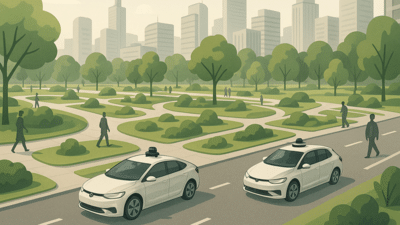Will change way of life: Ex-Tesla Autopilot head Andrej Karpathy makes a self-driving car prediction
Tesla ’s former head of Autopilot team, Andrej Karpathy , has made a major prediction about self-driving car technology. The computer scientist who is also noted for coining the term "vibe-coding,” which was named the 2025 "word of the year" by Collins Dictionary this month, has claimed that this technology will eventually "visibly terraform outdoor physical spaces and way of life," fundamentally altering urban environments. In a post on the social media platform X (formerly Twitter), Karpathy, who is also a founding engineer at ChatGPT maker OpenAI , said that while the transition would not be immediate, autonomous vehicles will reshape cities by bringing several changes.
fundamentally altering urban environments. In a post on the social media platform X (formerly Twitter), Karpathy, who is also a founding engineer at ChatGPT maker OpenAI , said that while the transition would not be immediate, autonomous vehicles will reshape cities by bringing several changes.
He expects a reduction in parked cars and parking lots, leading to more space being utilised for human activities. He also foresees significant improvements in safety for people inside and outside vehicles, along with a decrease in noise pollution. Karpathy, who left Tesla in 2022, also expects that autonomous cars will allow drivers to redirect their time and focus away from routine tasks like lane following. Moreover, he believes the technology will contribute to the delivery of physical goods, becoming more efficient and economical.
Ex-Tesla Autopilot head Andrej Karpathy’s self-driving car prediction
In his X post, Karpathy wrote: “I am unreasonably excited about self-driving. It will be the first technology in many decades to visibly terraform outdoor physical spaces and way of life. Less parked cars. Less parking lots. Much greater safety for people in and out of cars. Less noise pollution. More space reclaimed for humans. Human brain cycles and attention capital freed up from “lane following” to other pursuits. Cheaper, faster, programmable delivery of physical items and goods. It won’t happen overnight but there will be the era before and the era after.”
Karpathy’s comments reflect the views of many robotaxi supporters. At Tesla’s Cybercab unveiling in October, Elon Musk presented visual concepts of how autonomous vehicles could reshape urban spaces, suggesting that cities might convert parking areas into green zones.
Musk has also described Tesla’s Full-Self Driving as a feature that could give drivers more free time. In Tesla’s latest earnings call, he said the ability to text while the car operates on its own may become a key driver of interest in the Cybercab.
Texting while driving remains illegal in most US states, and robotaxis still need to advance before they can influence city planning in a meaningful way.
Tesla currently runs a robotaxi service with safety monitors in the passenger seat in Austin and offers an FSD-based ride-hailing option with a driver in San Francisco. Meanwhile, Google-owned Waymo provides driverless ride-hailing across five major US cities.
Both companies are looking to expand and continue testing in various parts of the country. However, they face challenges due to inconsistent robotaxi regulations, as rules for autonomous vehicles are primarily determined by individual states.
He expects a reduction in parked cars and parking lots, leading to more space being utilised for human activities. He also foresees significant improvements in safety for people inside and outside vehicles, along with a decrease in noise pollution. Karpathy, who left Tesla in 2022, also expects that autonomous cars will allow drivers to redirect their time and focus away from routine tasks like lane following. Moreover, he believes the technology will contribute to the delivery of physical goods, becoming more efficient and economical.
Ex-Tesla Autopilot head Andrej Karpathy’s self-driving car prediction
In his X post, Karpathy wrote: “I am unreasonably excited about self-driving. It will be the first technology in many decades to visibly terraform outdoor physical spaces and way of life. Less parked cars. Less parking lots. Much greater safety for people in and out of cars. Less noise pollution. More space reclaimed for humans. Human brain cycles and attention capital freed up from “lane following” to other pursuits. Cheaper, faster, programmable delivery of physical items and goods. It won’t happen overnight but there will be the era before and the era after.”
Karpathy’s comments reflect the views of many robotaxi supporters. At Tesla’s Cybercab unveiling in October, Elon Musk presented visual concepts of how autonomous vehicles could reshape urban spaces, suggesting that cities might convert parking areas into green zones.
Musk has also described Tesla’s Full-Self Driving as a feature that could give drivers more free time. In Tesla’s latest earnings call, he said the ability to text while the car operates on its own may become a key driver of interest in the Cybercab.
Texting while driving remains illegal in most US states, and robotaxis still need to advance before they can influence city planning in a meaningful way.
Tesla currently runs a robotaxi service with safety monitors in the passenger seat in Austin and offers an FSD-based ride-hailing option with a driver in San Francisco. Meanwhile, Google-owned Waymo provides driverless ride-hailing across five major US cities.
Both companies are looking to expand and continue testing in various parts of the country. However, they face challenges due to inconsistent robotaxi regulations, as rules for autonomous vehicles are primarily determined by individual states.
Next Story